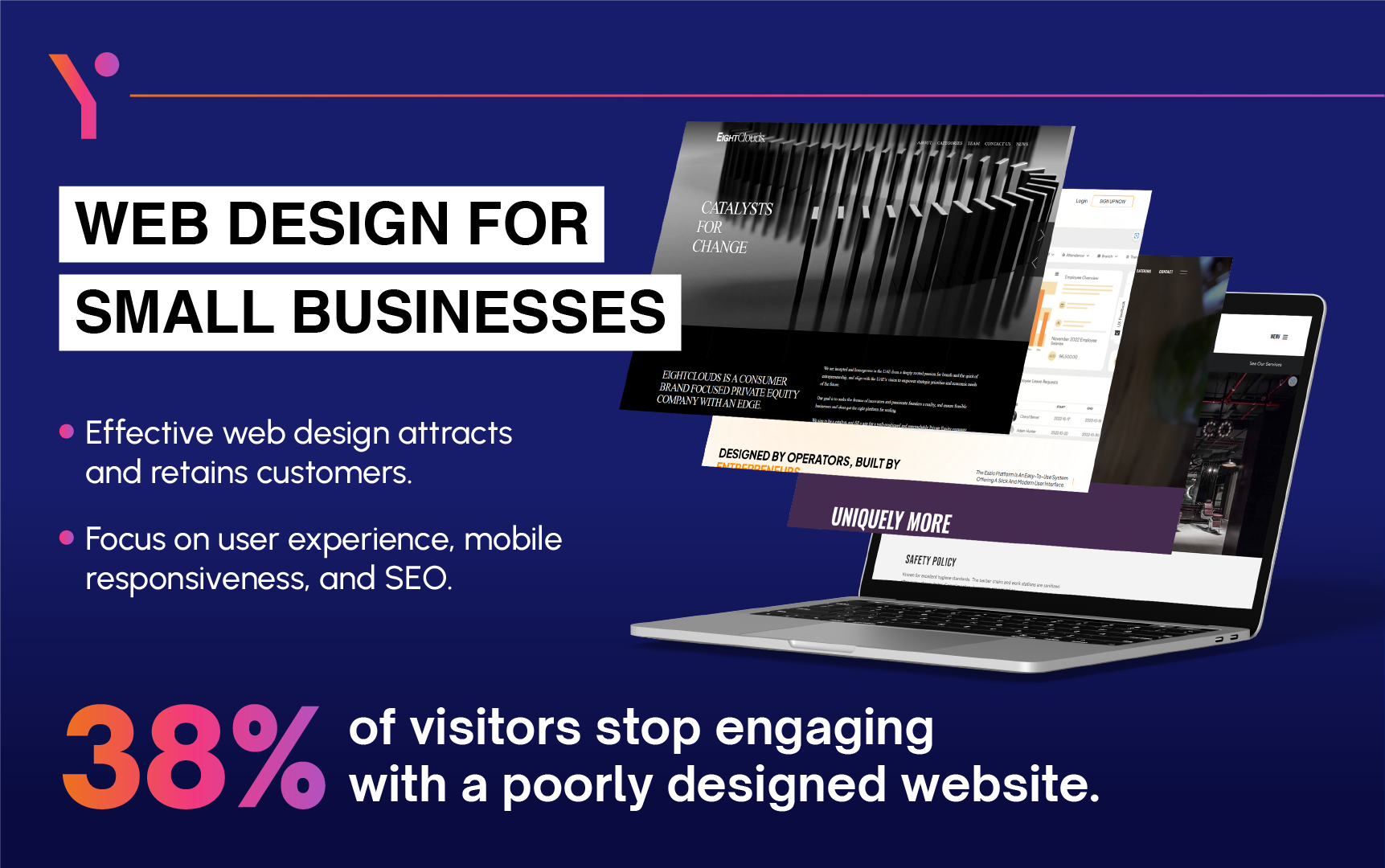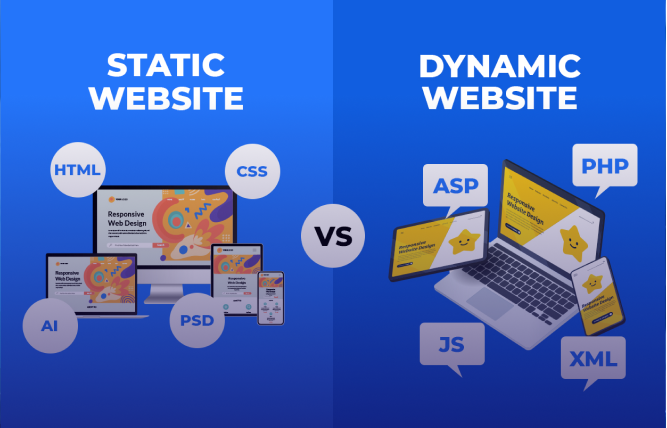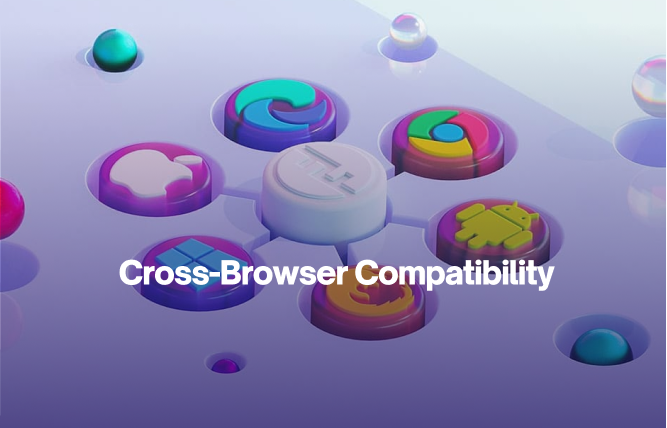Introduction
Today, a robust online presence is vital for small businesses. Web design for small businesses is more than just aesthetics. It is about driving sales and attracting customers. By giving priority to user experience with clear and concise navigation, mobile responsiveness and compelling content, you can create a website that converts visitors into leads. Ensure website security and implement SEO best practices. Routinely update your content and adopt design trends, all the while maintaining brand identity.
We are living in a very interesting digital landscape where a robust online presence is not a luxury for small businesses; it is a must-have. Due to the rise of e-commerce and the continuously increasing dependence on the internet for research, possible customers have a better chance to both discover and engage with businesses via their websites.
This is where web design for small businesses shows prominence.
Before getting into the main subject matter, understand that if you have a small business and need any sort of advice with regard to its website, contact FuturByte. We are a custom web development services provider that will be of great assistance to you. Also, we offer affordable web design for small business entities.
Watch Out: The Power of Web Design for Small Businesses
A properly designed website behaves as your digital storefront, capturing the attention of the customers and encouraging them to go through your offerings. Similar to a properly made physical store that makes a positive first impression, a robust web design for small businesses attains similar results online.
Let’s look at a table outlining the vital benefits of investing in a professional-looking and behaving website:
| Benefit | Description |
Improved Customer Acquisition | Any user-friendly website with obvious calls to action makes it easy for possible customers to find your company and perform the dealings. |
Increased Brand Awareness | A professional website assists in establishing your brand’s identity and leaving a lasting impression on possible customers. |
Enhanced Credibility | A professional and polished website showcases an image of competence and trustworthiness, giving possible customers confidence in the business. |
Cost-Effective Marketing Tool | Compared to conventional marketing methods, a website presents a cost-effective manner to reach a huge audience around the clock. |
Competitive Advantage | A properly designed website will assist you in standing out from the competition and attract the attention of a greater number of customers. |
If you need more information regarding any of the benefits mentioned above, contact FuturByte. We are a renowned custom web design and development company that will offer you beneficial information, and our advice regarding online web design for small businesses is sought across industries.

Benefits of a Robust Online Presence
A properly designed website is more than just aesthetics. It plays a vital role in driving business growth. Let’s look at how web design for small businesses can benefit a business in general:
Better Customer Engagement
An engaging and user-friendly website lets customers easily find what they require, learn a great deal about the business, and better connect with the business.
Increased Leads and Sales
By offering easily understandable information regarding your prices, services, and products, a properly designed website can convert website visitors into qualified leads or paying customers.
Better Customer Service
Being a small business owner, you can leverage your website to offer a 24/7 self-service portal for customers, replying to frequently asked questions and presenting resources such as FAQs, tutorials, and product manuals.
Data-Driven Decision Making
Today’s leading website analytics tools will let you effectively track user behaviour on your website. This will allow you to know what clicks with your audience and let you make informed decisions to optimise your marketing strategies and website performance.
Superior Brand Storytelling
Web design for small businesses lets you tell your brand story in an enchanting manner, exhibiting your values, mission, and whatever makes your business special. This will go on to harness a good level of emotional connection with your target audience.
Do you want to know how to boost your online presence? Contact FuturByte. We are a reputed WordPress web development services provider that can help you here. Also, our advice regarding small business web design packages can be of help to you.
Prominent Challenges Encountered by Small Businesses
It is true that web design for small businesses presents a host of benefits; the creation of a robust website can be a daunting task. Let’s look at some common hurdles that small businesses encounter:
Tight Budget
Availing the services of a professional (and possibly experienced) web designer can be a costly affair.
Lack of Technical Expertise
The setting up and maintenance of a website may demand some level of technical knowledge.
Problems in Defining the Target Audience
Your understanding of who you are attempting to reach is vital for creating a website that reverberates with them.
The Making of Content
Creating quality content that both engages and informs your audience can be somewhat of a time-consuming activity.
Being Up-to-Date
Web design for small businesses is evolving on a constant note. This is why keeping your website up to date with the newest trends and best practices is a challenging activity.
Do you want more information regarding the prominent challenges that small businesses face across industries? Contact FuturByte. We are a famed PWA development company that can offer you beneficial advice. Additionally, we offer E-commerce web design for small businesses.
Planning Your Website for Success
Prior to embarking on the designing activity, it is important for you to perform careful planning, which will ultimately lead to a successful website. Let’s take a look at some important steps to consider when planning your web design for small businesses:
Describing Your Target Audience
Getting to know your ideal customer is the base of a successful web design for small businesses strategy. Take a close note of their online behaviour, pain points, interests, and demographics.
Set SMART Goals and Objectives
Try to answer some important questions, such as:
- Do you want visitors to schedule an appointment, sign up for your newsletter, or make a purchase?
- What are the particular actions that you want your website to encourage?
It is important for you to set the SMART (Specific, Measurable, Achievable, Relevant, and Time Bound) goals.
Are you having trouble setting SMART goals and objectives? Contact FuturByte. We are an expert search engine optimisation services provider that can be of great assistance to you.
Set Up Your Brand Identity
It is important for your website to showcase your brand’s personality. Try to select fonts, a tone of voice, and colours that best align with your brand’s image. Always remember that consistency in web design for small businesses will assist you in building brand recognition and trust.
Select the Best Possible Website Platform
There are a host of website-building platforms that present drag-and-drop functionalities and user-friendly interfaces, making it easier for beginners to create their websites without much coding knowledge.
Design Tips for Small Businesses
So far, we have laid the groundwork for a small business website. Now, let’s get into the design aspect that will make it both visually appealing and user-friendly. Let’s look at some important web design tips for small businesses:
Keep it Simple – Prioritise Readability
It is important that you avoid filling your website with a lot of information or visuals. Make effective use of white space to improve readability and create a sense of balance. Go with easily readable fonts and keep a consistent colour scheme across your website.
Optimise for Mobile Devices
Due to the rising number of smartphone and tablet users, it is important for your website to be mobile-responsive. In other words, your website should amend its content and layout to display seamlessly on every device, thereby making sure there is a smooth user experience for every mobile visitor.
Web design for small businesses should prioritise mobile responsiveness across today’s digital landscape.
Use Clear Calls to Action (CTAs)
You have to inform your visitors what you want them to do next. It may be “Learn More,” “Buy Now,” or “Contact Us,” make sure to utilise clear and concise CTAs across your website. It is also important for you to ensure that your CTAs visually stand out and are easy to press/click.
Create Informative and Compelling Content
You must ensure that your website’s content is informative, concise, and clear. Use language that is easy for your target audience to understand, and try to shun technical jargon. Emphasise offering beneficial information regarding your products, services, and business.
Web design for small businesses is more than just aesthetics. It is about offering a beneficial user experience.
Prioritise User Experience (UX)
Your website should be easy for users to navigate. They should find their required information both intuitively and quickly. This includes keeping a consistent and clear layout, easy-to-find navigation menus, and a logical information hierarchy.
Go with Visual Appeal with High-Quality Imageries
High-quality visuals are important for getting viewer attention and keeping visitors engaged. Make use of professional videos, graphics, and photos that display your items, services, and brand personality.
Understand that visuals can prominently impact the general impression of your website in web design for small businesses.
Web Design Best Practices
Let’s be very clear here – web design for small businesses is much more than aesthetics; it takes into account the below-mentioned best practices that ensure optimal user experience and functionality.
The following are some important web design best practices to take note of:
Security – Safeguard Your Website and User Data
Your website’s security should be among your primary concerns. This is why you should implement robust security measures to safeguard your website from cyberattacks and protect user data. This includes making use of a secure socket layer (SSL) certificate and making sure your website software is up-to-date.
Accessibility – Serving Every User
Your website should be accessible to all, including users with disabilities. Go with alt text for images, guarantee a good level of keyboard navigation, and think about going with colour contrast for visually impaired users.
Web design for small businesses must be inclusive and serve users of various sorts.
Performance – Quick Loading Speeds
A slow-performing website is a big letdown for the visitors. This is why you should optimise your website for quick loading speeds. This will ensure that users go through a positive experience. The optimisation here includes selecting a reliable web hosting provider, minimising code, and optimising image sizes.
Content – SEO Optimised, Relevant, and Fresh
Regularly update your website content with relevant and fresh information. Include search engine optimisation best practices to improve your website’s ranking in search engine results pages (SERPs). Today, SEO experts agree that web design for small businesses must integrate SEO strategies to organically reach your target audience.
Navigation – User-Friendly and Intuitive
As hinted above, an intuitive and clear navigation system is of immense importance. This is why you should make use of well-labelled menus and breadcrumbs to assist users so that they may find their way around your website.
Serving Your Online Presence
You must never consider your website as a static entity. This is why if you want to keep a robust online presence and have better chances for continued success, and you must take note of the following steps:
Routine Content Updates
Try your best to keep your website content both relevant and new by routinely including fresh case studies, product descriptions, and blog posts. This will help with SEO and keep users engaged.
Analyse Website Performance with Metrics
Use website analytics tools to track user behaviour on your website. Perform analysis of metrics such as conversion rates, bounce rates, and page views to understand what requires improvement and what is working.
Prioritise Security Updates
Regularly update your website plugins and software to address security vulnerabilities and ensure a good level of performance.
Adapt Design Trends
In your attempts to maintain your brand identity, think about including some of the newest web design trends in your website. This should be done for the sake of a fresh and modern appearance. However, don’t go with prominent changes that may bewilder your present audience.
Concluding Remarks
Any investment in an effective web design for small businesses can present a prominent return on investment (ROI). A properly designed website is always in a great position to improve brand awareness, attract new customers, and also to drive sales growth.
If you follow the best practices and tips as stated above, you will be able to create a website that serves as a robust tool for your small business-related prosperity.
Finally, if you have trouble understanding any point mentioned in this blog, then contact FuturByte. We are a famed Joomla website developer company that will be of great assistance to you.
Frequently Asked Questions
A small business website should be both informative and clear. It must have easily findable contact details (address, email, phone). Make navigation intuitive, and try your best to make your site look user-friendly and flawlessly function on every device, especially mobiles.Also, inform visitors what to do next with an obvious call to action button, like “Shop Now” or “Contact Us.”
If you have a tight budget, then try to look into website builder platforms such as Squarespace or Wix. These offer pre-designed templates and drag-and-drop tools. This means that you will create a professional-looking website without doing a massive amount of investment or doing extensive coding.
Having high-quality visuals while keeping a website quick enough is a bit tricky. This is where you need to focus on the right balance. Optimise image formats and sizes to decrease file size without bringing down quality.Strategically utilise high-impact visuals and prioritise faster load times.
Search Engine Optimisation assists your website in ranking higher in search results. Emphasise adding relevant keywords across your website content, especially in headings, descriptions, and titles.Make sure you have a mobile-friendly website and a clear structure for search engines to crawl.Local businesses should go through local SEO strategies to get discovered by customers in an area.
First, understand that you don’t require a web designer all the time you want to update your website. Various website builders present user-friendly editing tools. These will let you easily swap images, update content, and include new features.This means your website will stay “fresh” and engaging for visitors without requiring constant professional assistance.
Have questions or feedback?
Get in touch with us and we‘l get back to you and help as soon as we can!




